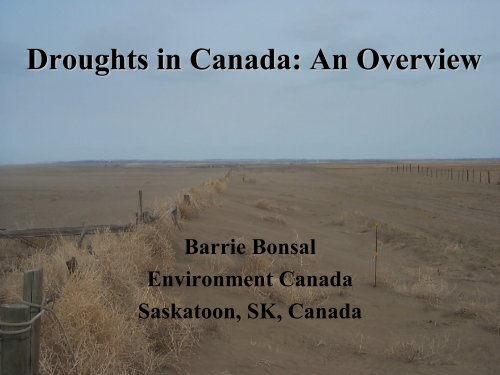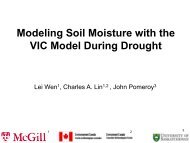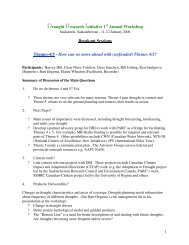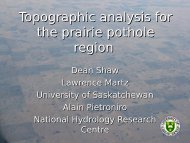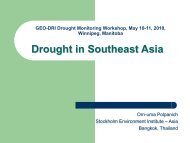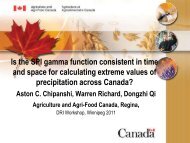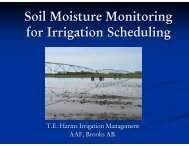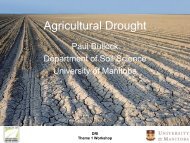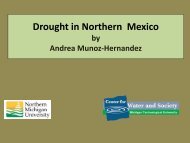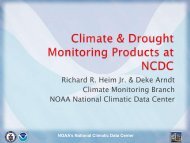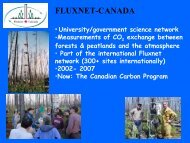Droughts in Canada: An Overview - Drought Research Initiative
Droughts in Canada: An Overview - Drought Research Initiative
Droughts in Canada: An Overview - Drought Research Initiative
- No tags were found...
You also want an ePaper? Increase the reach of your titles
YUMPU automatically turns print PDFs into web optimized ePapers that Google loves.
<strong><strong>Drought</strong>s</strong> <strong>in</strong> <strong>Canada</strong>: <strong>An</strong> <strong>Overview</strong><br />
Barrie Bonsal<br />
Environment <strong>Canada</strong><br />
Saskatoon, SK, <strong>Canada</strong>
Outl<strong>in</strong>e<br />
• Background<br />
• Past drought occurrence<br />
• Large-scale atmospheric causes<br />
• Current monitor<strong>in</strong>g & prediction<br />
• Future droughts<br />
• <strong>Research</strong> requirements
<strong><strong>Drought</strong>s</strong> <strong>in</strong> <strong>Canada</strong>
<strong>Drought</strong> Impacts<br />
Agriculture
<strong>Drought</strong> Impacts<br />
Water Resources
<strong>Drought</strong> Impacts
<strong>Drought</strong> <strong>Research</strong> <strong>in</strong> <strong>Canada</strong><br />
• Fragmented – spatially and<br />
temporally<br />
• Based on severe drought<br />
occurrence (e.g., 1999-2005)<br />
• Majority for Canadian Prairies<br />
• Historical comparisons difficult<br />
due to short and variable climate<br />
station records<br />
• Canadian droughts unique – both<br />
cold and warm season<br />
phenomenon
a) Kamloops, BC<br />
-6<br />
-4<br />
-2<br />
0<br />
2<br />
4<br />
6<br />
1900<br />
1905<br />
1910<br />
1915<br />
1920<br />
1925<br />
1930<br />
1935<br />
1940<br />
1945<br />
1950<br />
1955<br />
1960<br />
1965<br />
1970<br />
1975<br />
1980<br />
1985<br />
1990<br />
1995<br />
2000<br />
b) Saskatoon, SK<br />
-6<br />
-4<br />
-2<br />
0<br />
2<br />
4<br />
6<br />
1900<br />
1905<br />
1910<br />
1915<br />
1920<br />
1925<br />
1930<br />
1935<br />
1940<br />
1945<br />
1950<br />
1955<br />
1960<br />
1965<br />
1970<br />
1975<br />
1980<br />
1985<br />
1990<br />
1995<br />
2000<br />
c) Sherbrooke, QC<br />
-6<br />
-4<br />
-2<br />
0<br />
2<br />
4<br />
6<br />
1900<br />
1905<br />
1910<br />
1915<br />
1920<br />
1925<br />
1930<br />
1935<br />
1940<br />
1945<br />
1950<br />
1955<br />
1960<br />
1965<br />
1970<br />
1975<br />
1980<br />
1985<br />
1990<br />
1995<br />
2000<br />
d) Yarmouth, NS<br />
-6<br />
-4<br />
-2<br />
0<br />
2<br />
4<br />
6<br />
1900<br />
1905<br />
1910<br />
1915<br />
1920<br />
1925<br />
1930<br />
1935<br />
1940<br />
1945<br />
1950<br />
1955<br />
1960<br />
1965<br />
1970<br />
1975<br />
1980<br />
1985<br />
1990<br />
1995<br />
2000<br />
<strong>An</strong>nual PDSI<br />
<strong>An</strong>nual PDSI<br />
<strong>Drought</strong> Occurrence
Reconstructed Regional July Palmer <strong>Drought</strong> Severity Index<br />
(Sauchyn et al. 2001)<br />
2<br />
Southwestern<br />
Saskatchewan<br />
0<br />
-2<br />
frequent<br />
drought<br />
1700 1800 1900 2000<br />
2<br />
decadal<br />
drought<br />
0<br />
-2<br />
North-central<br />
Montana<br />
1600 1700 1800 1900 2000
Warm, Dry W<strong>in</strong>ters Over <strong>Canada</strong><br />
500mb Flow<br />
500mb <strong>An</strong>omalies<br />
El Niño, +PNA, +PDO, Deep Aleutian Low
Hot, Dry Summers Over Western <strong>Canada</strong><br />
500mb Flow<br />
500mb <strong>An</strong>omalies<br />
+PNA, Meridional Flow, +PDO
Coupled SVD pattern between Global<br />
W<strong>in</strong>ter SSTs and Summer PDSI<br />
(1940-2002)<br />
W<strong>in</strong>ter Interannual and <strong>in</strong>terdecadal ENSO-like pattern is associated with dry<br />
summer conditions <strong>in</strong> western and central <strong>Canada</strong>. Squared Covariance Fraction<br />
= 28%, Correlation between time expansion = 0.5<br />
(Shabbar and Sk<strong>in</strong>ner, 2004)
<strong>Drought</strong> Monitor<strong>in</strong>g<br />
• Real-time <strong>in</strong>formation on drought<br />
conditions over agricultural regions<br />
of <strong>Canada</strong><br />
• National map illustrat<strong>in</strong>g current<br />
and historical temperature,<br />
precipitation, and drought <strong>in</strong>dex<br />
maps (SPI, PDSI) at various time<br />
steps<br />
• Reports of lake and reservoir<br />
levels, stream flows, snowpack<br />
accumulations, water-supply<br />
volume forecasts, dugout water<br />
levels, pasture conditions (for the<br />
Prairies)<br />
• The North American <strong>Drought</strong><br />
Monitor
<strong>Drought</strong> Prediction<br />
• <strong>Drought</strong> prediction <strong>in</strong>volves<br />
anticipat<strong>in</strong>g climatic anomalies that<br />
produce unusually hot, dry conditions<br />
for extended periods<br />
• EC currently produces 3-month<br />
determ<strong>in</strong>istic T & P forecasts for lead<br />
times of 3, 4, 6, 9, and 12 months<br />
• The 3 & 4 month lead time forecasts<br />
are based upon and ensemble of 40<br />
model runs (GCM & NWP)<br />
• Longer lead times use a statistical<br />
(CCA) model us<strong>in</strong>g SST anomalies<br />
over the previous 12 months<br />
• Skill higher for cold season and for<br />
temperature
Future <strong><strong>Drought</strong>s</strong><br />
SPI<br />
PDSI
<strong>Research</strong> Needs<br />
1. A better understand<strong>in</strong>g of the physical causes of drought<br />
<strong>in</strong>itiation, persistence, and term<strong>in</strong>ation at a variety of spatial and<br />
temporal scales<br />
• Large-scale atmospheric and oceanic oscillations<br />
• Soil moisture anomalies<br />
• Storm tracks<br />
• Moisture sources<br />
• Physical causes of multi-year droughts<br />
• <strong>Drought</strong> migration
<strong>Research</strong> Needs<br />
2. Quantification and assessment of past drought occurrences<br />
• Past trends and variability<br />
• <strong>Drought</strong> <strong>in</strong>dices<br />
• Paleo-drought studies<br />
3. Better knowledge regard<strong>in</strong>g future drought occurrence<br />
• More reliable GCM/RCM output<br />
• Improved downscal<strong>in</strong>g methods<br />
• Future changes to large-scale circulation patterns
<strong>Research</strong> Needs<br />
4. Ability to more accurately predict drought onset, <strong>in</strong>tensity, and<br />
term<strong>in</strong>ation<br />
• Improvements <strong>in</strong> modell<strong>in</strong>g and monitor<strong>in</strong>g of current drought<br />
conditions<br />
• More reliable short term (seasonal) climate forecast<br />
5. More effective short and long-term adaptation strategies to<br />
defend aga<strong>in</strong>st future droughts


